Video of the Via Ferrata in Gaucin
What is a Via Ferrata?
Via Ferrata comes from Italian and can be loosely translated as “iron road" or “iron way.”
The central theme of any ferrata is a thick steel cable that is fixed to the side of a mountain. The cable is the backbone of any ferrata route and should provide all the safety you will need. This'lifeline' is drilled into the rock face every few metres, thereby limiting any falls.
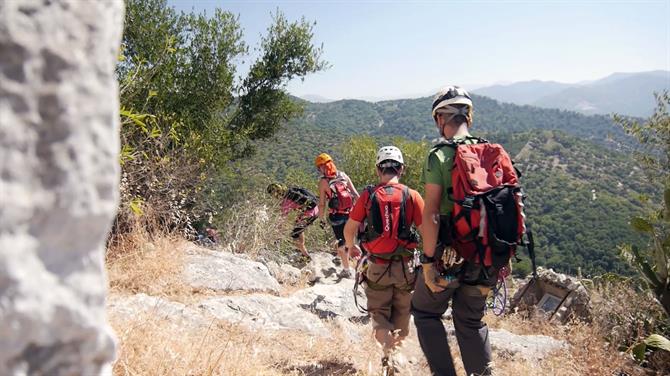
Running parallel to it there are usually metal steps, known as stemples, pegs and sometimes even carved stone ledges that make climbing easier.
These are inter-spaced with bridges of various kinds, zip lines, overhangs and many more fun features.
Grading of Via Ferratas in Spain
The routes themselves vary considerably in length and difficulty. There are at least five international grading systems that change from country to country.
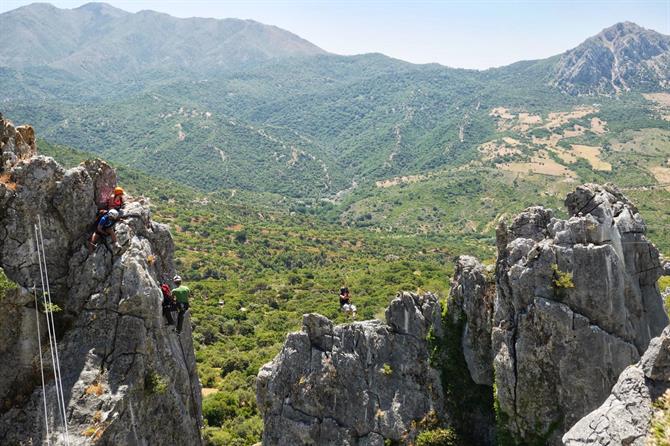
Via ferratas tend to be graded according to the hardest section of the passage. There are other specific via ferrata factors that should be taken into consideration, such as the strength and endurance required, the psychological difficulty - how ariel and exposed the route is? The actual ferrata installation - is it new and in good condition? Are there escape routes and the location - is it easily accessible, mid or high mountain etc.?
Many countries have adopted the traditional alpine grades (1 - 6) although the individual grading of ferratas bears little resemblance to their alpine counterparts.
The Austrians use an alphabetical system first introduced by the Kurt Schall guides (Klettersteig-Atlas series) which uses an A to E and a five point scale, with E5 being extremely difficult.
In Spain, a hybrid system that incorporates the Swiss - Eugene Hüsler's scale is slowly being introduced for via ferratas. Hüsler's scale ran from "very easy" to "extremely difficult," originally on a scale of K1 to K6 and is now commonly referred to using the letters A through E.
Another classification that is still widespread and was developed by the Spanish mountaineering magazine Desnivel is one that is based on colour coding. It goes from green (easy) to black (very hard).
Generally speaking, the A through E, Hüsler's scale has been adopted and uses the specific ferrata grading mentioned above. For more information see deandar.com.
The history of Via Ferratas
The exact origins of via ferratas is widely disputed.
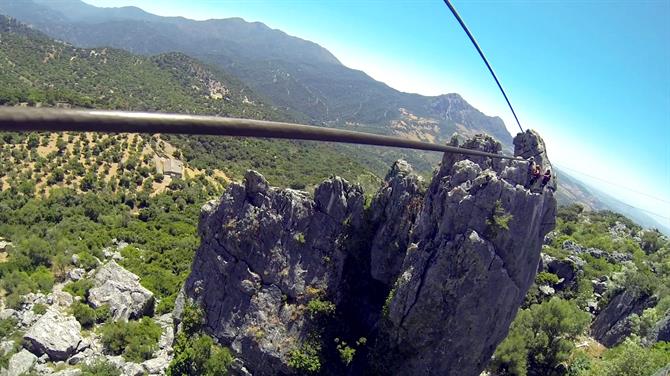
The earliest records seem to point to the Alps. Steps, ropes and basic pulley systems have existed in the Alps for hundreds of years. They were (and still are today) used to connect remote villages to the higher grazing pastures.
The Austrians, however, are often credited with being the first people who built the modern equivalent of today’s iron way routes.
During the First World War, the Austrians and the Italians fought a ferocious war in the Dolomite mountains. Ropes, ladders and tunnels were created by soldiers who were trying to control the higher mountain passes. These peaks provided unbridled positions to field larger guns and for observation posts.
To help the troops and to move equipment, permanent lines were fixed onto the rock faces and wooden ladders were installed, thereby enabling soldiers to ascend steep faces with relative ease.
This war time network was restored after the Second World War and today provides the longest, most impressive via ferratas route in the world. The Mecca for via ferrata enthusiasts.
Via Ferratas in Andalucia
The province of Andalucia is blessed with some of Spain’s most beautiful and mountainous landscape. The Junta de Andalucia has seen the importance of exploiting these natural wonders and over the last few years, there has been a concerted effort to encourage inland and especially active tourism.
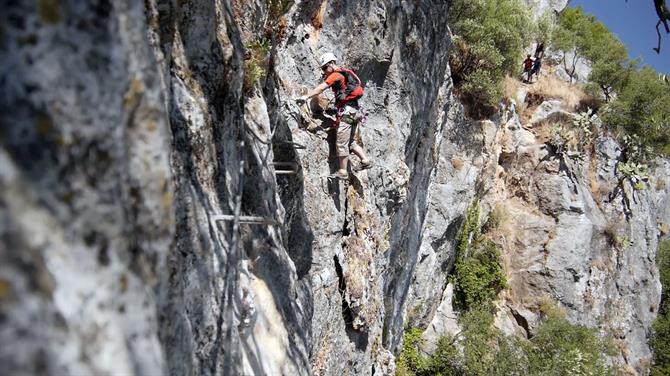
The existing via ferrata network has benefited from this initiative. Many of the via ferratas in the province have recently been created and/or modernised and often in conjunction with local adventure sports companies.
They tend to be based in areas where some form of previous installation existed. A number of vias follow old mountain passes that were used by electrical engineers for example.
Serrania de Ronda - the via ferrata park
There are now numerous routes in and around the Province. The jewel in the crown has to be the Serrania de Ronda - the Ronda mountains. The area is commonly referred to in the Spanish press as being Spain’s first “Via Ferrata park.” It is attracting people from all over Spain and further afield.
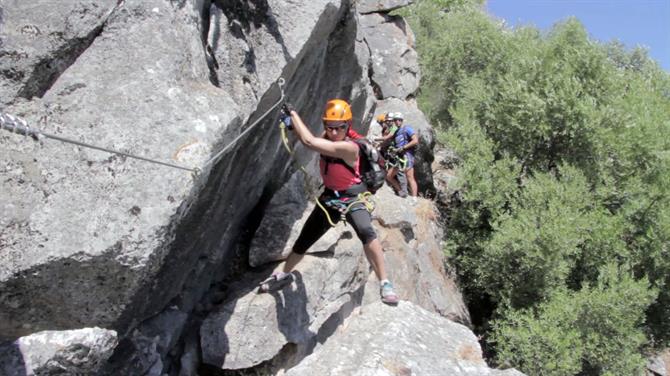
In the words of Jesús Olvera from Al Andalus Activa “what we have seen here has been nothing short of revolutionary, with people coming from all over Europe to experience our ferratas.”
Considering that the last route to be opened, was at the beginning of July 2013, in the Tajo de Ronda (the Ronda gorge) and only cost 500€ to update the existing installations. It is an investment that is proving to pay off quickly.
In Ronda’s immediate vicinity, there are now 11 via ferrata routes, with several more in the pipeline. Two in Ronda itself (both in the Tajo area), there are two in Gaucin, and one each in Benalauría, Cartajima, Montejaque, Igualeja, Benaoján, Benadalid and Atajate.
Via Ferrata Gaucin
The via ferrata route in Gaucin is one of the most difficult/technical ones around.
Every mention of the via ferrata that i came across had its difficulty listed as medium/high with a high level of fitness required. A grade 'B/C' on the Hüsler's scale. I’d have to agree with that. Fitness is quite important, your arms and legs get surprisingly tired hanging on for dear life.
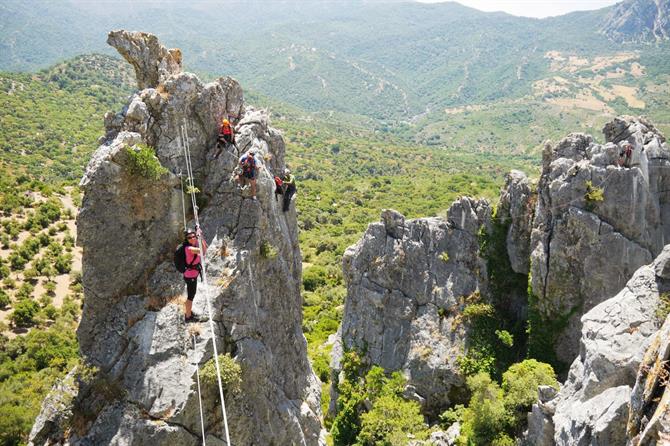
Unlike many other of the ferrata routes, you start at the top and go downwards and across. Which adds to the difficulty. Upon entering the main section of the ferrata you need to scale a rock face horizontally and downwards, which adds a lot of weight bearing on your arms.
In saying that, it is a spectacular route and with two ‘Monkey bridges,’ one larger ‘Tibetan bridge’ and a 30m zip line. The bridges take some getting used to.
The monkey bridge is particularly scary. You have to balance yourself and walk sideways along one cable, whilst holding onto the one above you, the smallest amount of wind, trembling legs etc sets you off into what seems like perpetual motion, with your legs moving the cable beneath you, causing the one above you to move and so on....the secret lies in staying calm, not moving and waiting until the 'movement' has ceased. At most points you are more than 80m above the ground. It is not for the faint hearted.
The whole installation on Gaucin's larger via ferrata is new and approximately 200m in length.
Getting there
There are actually two via ferrata routes in Gaucin. The one mentioned above, known as the Eagle Castle - Castillo delÁguila route and the older Hacho one.
Getting there is very straightforward. You drive through the centre of Gaucin, always following signs for the Castle. You can park within very easy walking distance from the start of the route. Following the path up towards the castle, just before you reach it, there is a small track that leads off to the right - the start of the ferrata. It is signposted. Map
If you want to see and experience a completely different side to Andalucia, be sure to try out some of the via ferrata routes.
Love or hate it, doing a via ferrata really does provide an unforgettable experience.......one that will make you want to try them again and again.....or an experience that will turn you into a quivering mess. Either way it is an experience that must be tried!
